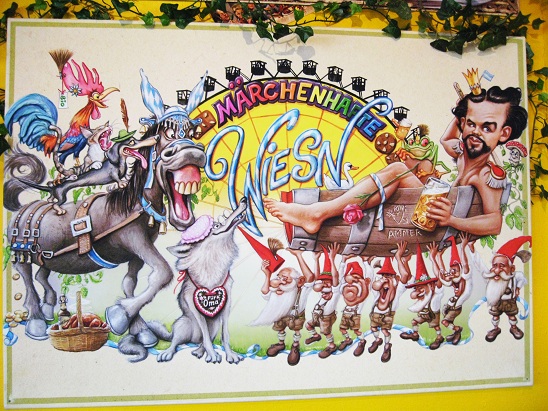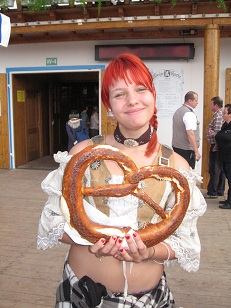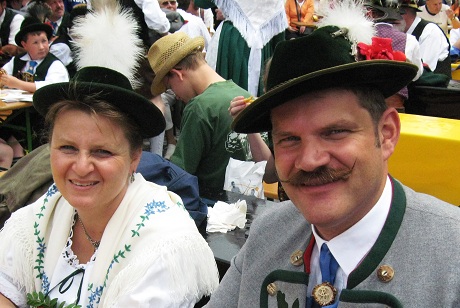|
DAY 11
OKTOBERFEST AT THE WIES'N
OVERNIGHT IN MUNICH
We drive north on the autobahn to Prien, a resort town on the Chiemsee (Chiem Lake,
pronounced Keemzay in German.)
Known as the "Bavarian Sea," Chiemsee is the largest of the Bavarian lakes at
32 square miles. On the island of Herrenchiemsee, King Ludwig II built his copy of
the palace at Versailles, with its awesome Hall of Mirrors.
A tour by bus highlights the main sights of Munich outside of the downtown
pedestrian zone. See the Residenz, the home of the Wittelsbachs, an imposing complex
developed phase by phase through four centuries.

After checking into our hotel, we proceed to the Theresienwiese, the site of the
Oktoberfest Bier Festival.
The first Oktoberfest was held in 1810 in honor of the Bavarian Crown Prince
Ludwig’s marriage to Princess Therese von Sachsen-Hildburghausen. The festivities
began on October 12th and ended on October 17th with a horse race.
In the following years, the celebrations were repeated. later, the festival was
prolonged and moved forward into September. By moving the festivities up, it allowed
for better weather conditions. Because the September nights were warmer, visitors were
able to enjoy the gardens outside the tents and the stroll over “die Wiesn”
or the fields much longer without feeling chilly.
Historically, the last Oktoberfest
weekend was in October and this tradition continues into present times.
Oktoberfest Photos by Alfred Molon
Oktoberfest-TV.com
DAY 12
MUNICH WALKING TOUR
AFTERNOON FREE FOR SHOPPING OR MUSEUMS
OVERNIGHT IN MUNICH
Munich (German: München)
is the capital and principal city of the state of Bavaria
and the third-largest city in Germany (after Berlin and Hamburg).
Munich is situated in the valley of the Isar River, a tributary of the Danube,
about 48 km (30 mi) north of the foothills of the Alps.
The city has an area of 310 sq km (120 sq mi) and a predominantly Roman Catholic
population of 1.35 million.
The city's name is derived from Munichen, which means "home of the
monks." Munich was established in 1157 when Henry the Lion, duke of Bavaria,
granted trade, coinage, and customs privileges to a market center established
by monks near their monastery, probably founded in 750.
Munich is the seat of the Bavarian state government and a major transportation,
commercial, and industrial center.
Munich is famous for its beer, but machinery, automobiles, furniture, clothing,
optical instruments, and electronic equipment are more significant manufacturers.
Craft industries such as glass staining, wood carving, and silver and bronze
founding are well known.
Publishing and filmmaking are important, as are the
fashion and high technology industries.
The oldest part of the city, dating from the 12th to 14th centuries, was built
in the form of an irregular semicircle around the original settlement on the
left bank of the Isar River.
Our walking tour of the Altstadt begins at 9:30 am. You will see
(1) Karlsplatz, the hub of the subway lines and an underground shopping complex
connected to several major department stores,
(2)
St. Michael's Church , the largest Renaissance church in northern Europe,
where Bavaria's former royal family, the Wittelsbachs, are entombed,
including
King Ludwig II,
(3) the
Frauenkirch,
whose twin towers are the oldest and best-known landmarks
of Munich, built between 1468 and 1488 and restored following damage
in World War II.
The center of the Old Town (and Munich) is the
Marienplatz
(Saint Mary's Square),
with the former town hall, a Gothic structure dating from 1470s and the
"new" City Hall, completed at the end of the 19th century.
Together with a crowd of other tourists, we watch the figures dance in the Rathaus
(City Hall) glockenspiel.
This area is Munich's shopping center, a delightful pedestrian zone
where you can wander from store to store.
Close by the Marienplatz is the
Munich Residenz, which served as the seat of government
and residence of the Bavarian dukes, electors and kings from 1508 to 1918.
This "residenz" or home of the Wittelsbach rulers of Bavaria developed phase by phase through
four centuries.
The Residenz houses the Residenz museum, the Treasury, the Cuvilliés-Theater and the
Allerheiligen-Hofkirche. The complex
as a whole is one of the largest museums in Bavaria.
The Schatzkammer der Residenz
is one of the great European treasuries,
a first-rate collection of secular and ecclesiastical objects.
The most famous pieces are the Royal Bavarian Crown and the St. George
statuette, a bejeweled masterpiece encrusted with rubies, pearls, diamonds
and emeralds.

Antiquarium in the Munich Residenz
The "Antiquarium" hall is the oldest room of the Residenz München. 66 metres long,
it is the largest
and most lavish Renaissance interior north of the Alps.
The Wittelsbach patron of the arts
Duke Albrecht V had it
built from 1568 to 1571 for his collection of antique sculptures. These
antiquities gave the room its name "Antiquarium".
The 16 pictures along the top of the vault are the work of the Munich court
painter Peter Candid and show allegories of Fame and Virtue in the form of
seated female figures.
The vaults above the windows, and the window jambs, are decorated with 102
views of towns, markets and palaces in what was then the Duchy of Bavaria.
Art lovers will certainly want to visit the
Neue Pinakothek,
which houses one of the most comprehensive collections of 19th century
paintings.
Do not miss
Die Arme Poet (The Poor Poet) and other works by
Carl Spitzweg (1808-1885.)
This Munich-born German romanticist is famous for his paintings reflecting,
with sympathetic humor, aspects of middle-class German life in the 19th-century.
Across the street is the newly-renovated Alte Pinakothek. The major
exhibits include
Albrecht Dürer's Four Apostles
and his self-portrait in a Christ-like pose.
Not far away on the Isar River is the
Deutsches Museum
(German Museum),
with 18,000 exhibits, the world's largest museum of science and technology.
This technophile's paradise contains the world's first motorcar, locomotives,
ships, airplanes, and over one thousand models, experiments and demonstrations
you can operate by hand or by pushing a button.
It would be difficult to even race through these museums in a single
afternoon. Perhaps you might want to consider staying over an extra day
or two in Munich.
That way, you could also fit in a visit to the
BMW Museum,
out on the Mittlerer Ring, across from the site of the 1972 Olympics.
Tonight we end our tour with dinner and music at the famed Hofbräuhaus.

DAY 13 / WEDNESDAY / SEPTEMBER 30
RETURN TO USA
Fly to your home city.
(Or extend your stay. We will help you make plans or reservations.)
|




